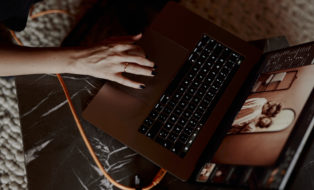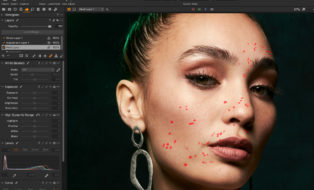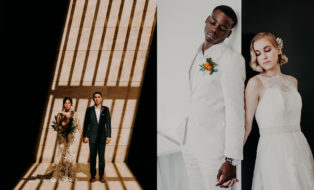In Capture One Pro 8 it is also now possible to change the White Balance in a Local Adjustments layer.
The ability to change the White Balance locally in an image can be very useful for instance when shooting architecture images at dusk time. Here the difference in color temperature between the outdoor dusk light and the lighting in the buildings can be quite big, resulting in unnatural-looking colors.
New opportunities with your images
But even in landscape images it can be beneficial to work with different White Balances as there can be quite a big difference between shadow areas and areas with sunlight. Often if you open op some shadow areas in a landscape image, it becomes even more obvious that the shadows typically get their main light from the deep blue color of the sky. With the ability to change the White Balance individually between the areas with direct sun and the shadow areas you get entirely new opportunities with your images.
 Straight from the camera Shadows opened Local White Balance applied
Straight from the camera Shadows opened Local White Balance applied
3 versions of the same image
Above you see three different versions of the same image. For all three images the White Balance for the background is the same. The image has been exposed to ensure details in the sunlit cliffs in the background leaving the foreground quite dark.
The left image is straight out of the camera. For the image in the middle the shadow areas of the foreground have been opened by using the shadow slider in the High Dynamic Range tool. It is quite obvious that the foreground gets very bluish because it is primarily lit by the deep blue sky. You first notice this after the shadows have recovered.
For the image to the right a local White Balance has been applied to a Local Adjustments mask covering the cliffs in the shadow areas. By doing this it is possible to balance the color of the foreground to match the colors of the background giving a much more realistic and pleasing image.
In the Local Adjustments tool you will by default see all the tools that can be used in a Local Adjustments layer and in Capture One Pro 8 you will also see the White Balance tool.
Let’s look at another example with an architecture image shot at dusk time. The image was shot using White Balance set for Tungsten. This is often a good starting point as the sky typically gets deep blue and the indoor light doesn’t get too far off.
 Architecture image at dusk time captured using tungsten White Balance.
Architecture image at dusk time captured using tungsten White Balance.
It is quite obvious that the indoor lighting looks quite ugly. The lights in the big central office areas have a green cast while the most other offices get a slightly orange cast.
Here the new feature of being able to change the White Balance locally can be a big help. I would like to preserve the nice deep blue sky but I would also like to change the color of the indoor lighting to a more pleasing warm tone.
I am actually quite satisfied with the color of the blue sky so I will leave the White Balance for the Background layer at Tungsten. I can at any time later fine-tune the White Balance for the background layer without changing the White Balance for any of the adjustments layers I make.
Making an Adjustments Layer for a local White Balance
I start by adding a new adjustments layer by clicking on the + button at the button of the Local Adjustments tool. I create a layer for the central office in the building with the green cast and a mask for the other offices.
 Press the “+” button to add a new adjustments layer
Press the “+” button to add a new adjustments layer
For both layers I draw a mask using hardness of 0 and opacity 100. Only if you use opacity set to 100, you can adjust the White Balance in an Adjustments Layer and the background layer independently of each other.
With the brush cursor tool selected you can use “M” to toggle between showing the mask or not.
I start focusing on the mask for the center office with the green cast by selecting Layer 1. I will start using the White Balance picker to neutralize the light. I simply pick on the white office ceiling. Setting the Local White Balance this way immediately removes the green cast, but I would also like to add a warm yellow tone to the light. I will do so by dragging the Kelvin slider towards higher values until I get a tone I like.
 Original value Picked White Balance Changed Kelvin value
Original value Picked White Balance Changed Kelvin value
The images above show the steps for toning the light in the central office of the building. The first image is without a Local White Balance. In the center image I have used the White Balance picker and picked on the sealing of the center office. This neutralizes the light and gives me a good starting point for toning the light warmer. In the image to the right I have used the Kelvin slider to tone the light to a warm yellow tone.
Next I will tone the light for the rest of the offices in the building. I will simply repeat the steps I did for the Layer 1.
 Layer 1 optimized Layer 1 and 2 optimized
Layer 1 optimized Layer 1 and 2 optimized
You may need to tweak both the Kelvin and the Tint slider in the White Balance tool to match the tone of the light in the center office to the rest of the offices.
Looking at the optimized image it becomes obvious that I also need to fix the tone of the light reflection in the water.
I could make another Adjustments Layer for the reflection but I will just add it to one of the masks. For the reflection it is just a matter of toning it away from the green/blue color into something warmer so it doesn’t matter, which adjustments layer I use. What is important though is that I only use an opacity of around 30 to 50 and a large brush with hardness 0. This gives me a nice warm tone that blends nicely into the blue reflections of the sky and the blue light on the ground floor of the building.
 Wrong reflection in the water Reflection in the water fixed
Wrong reflection in the water Reflection in the water fixed
Finally let’s compare the original and the fixed image.
 Original image Fixed with Local White Balance
Original image Fixed with Local White Balance
The ability to work with different White Balances in the same image gives me in this example the possibilities to turn this image into a much more interesting image of a modern office building. Who would like to work in a building with green light ?
All the best,
Niels

The Image Quality Professor
The digital pioneer, Niels V. Knudsen, is Phase One’s Image Quality Professor and founder of the IQP blog. Moreover, he is responsible for breakthrough advancements in image quality both in Phase One’s medium format camera systems and in Capture One Pro.





Great new feature. I see it coming to use in many occasions. E.g. also when having daylight fall into a room mainly lit by artificial light.
Hi Per,
Thanks for your feedback.
Really glad to hear!
All the best,
Niels
This “local WB adjustment” is one greatly appreciated new features of CO8!
Hi Kodiak,
I am happy to hear!
All the best,
Niels
Many thanks for that, Niels. You’ve helped me rescue a picture I’ve been wrestling with, on and off, for a couple of weeks.
I always look forward to these tutorials.
Regards,
Roger
Hi Roger,
Happy to hear that the tutorial was helpful.
And thanks for the kind words.
All the best,
Niels
many thanks
i have a lot of photo’s with a mixture of WB i never could get it right .
Glad it was helpful!
All the best,
Niels
White Balance in Local Adjustments was a feature I was longing for.
I tried but it is not working for me!! Please help.
I am using the 8.0.2 64bit version on Windows 7
Hi Vallabh,
Good to hear that you like the tool.
We would need a few more details to locate the issue. If you log a ticket here:
http://www.phaseone.com/en/SupportMain.aspx
Our support team will help you asap!
All the best,
Niels
Thank you Neils, for your quick response.
Thanks for all your tips on Capture One pro 8. It takes a lot of re-learning after all the years with Photo Shop. But well worth it, so all the help you can give is welcome.
I have made a Phase One File on my Macs Bookmark for all your tips for future reference. I must check out your archive of tips (do you have one?) to book mark as well.
Thank you for your help.
Michael
Hi Michael,
I am happy to hear that you like the tutorials. Unfortunately I do not have an archive with all my posts.
But I will consider doing one. Thanks
All the best,
Niels
Great tutorial and a very helpful tool, just wondering about the lower floor office on the left which has not be changed, I expect there is a good reason for this?
Thanks
Dave
Hi Dave,
Thanks for the kind words.
The light in the office on the lower floor was actually bluish and I left it because I actually liked it that way.
All the best,
Niels
I have been using Capture One for 3 years since version 6. I am happy to see all the improvements that I have been looking for. Great tutorial, thanks.
Paul
I love the idea of local adjustments but I find painting the mask a bit clumsy. Is there an option to put a lassoo around the area and select a whole section of the image so you can do it in a few seconds like an adjustment layer in photoshop. I would rather use your app as it’s far superior when it comes to raw image manipulation but I tend to resort to PS for speed.
Cheers Bay
Bay,
Perhaps you can use the “auto fill” (I think that’s what it’s called) feature? You paint the edge and then it fills automatically.
Hi Bay,
Thanks for the kind words.
Per Karlsson’s suggestion is right. The Auto fill mask can help you with this.
All the best,
Niels
A great tool that’s been missing for far too long! 🙂
As I do understand your reasoning of local and global WB being independent in C1 I do not fully appreciate it and I wish there was at least an option to relatively link local WB to global WB.
A switch for each Adjustment Layer would be a killer implementation!
What if I have a number of Adjustment Layers with WB correction and I decide I want the whole image to be warmer or cooler? Not an untypical decision, is it?
Then I have to go in and re-adjust WB layer for layer. After all ANY other parameter in Adjustment Layers WILL be affected by global changes – Exposure as a prime example.
So please reconsider … there’s always a way for improvement. 🙂
Hi Thomas,
Good to hear that you appreciate the tool and thanks for your feedback. I always prefer to work with independent white balance layers.
But I see your point, that it once in a while can be useful to have them linked.
All the best,
Niels
Niels, always look forward to these tutorials. I’ve found myself doing a lot more of these image types. The local white balance in pro 8 will be a big help. Thank you for the diverse examples.
Scott
Hi Scott,
Good to hear. I am happy that it’s helpful.
All the best,
Niels
Thank you! Great feature 🙂
Hi John,
Thank you. Glad you like the feature!
All the best,
Niels
New local adjustment tools are pretty cool! Main disadvantage of using them is lack of masking tool options. Brush is definitely not enough! It will be great to use, say, poligonal lasso tool with ability to change fuzziness of its borders. It is not easy to draw straight line with brush only.
Hi Roman,
Good to hear.
Thanks for your input.
Happy Holidays,
All the best,
Niels
I’ve noticed options such as “Pick whitebalance on selected layer” and “Pick color correction on selected layer” How do these integrate into selective white balance correction.
Thanks
Hi Joe,
If you want to use selective color correction in a layer, where you also want to do local WB correction, you need to set the local White Balance before you pick the colors you want to change, as the colors are dependent on the White Balance of the local layer.
All the best,
Niels
Hi Professor Niels?
How about built in “Color Checker Tab” in Base Characteristic of Color tool tab” such as Davinci Resolve? i was talk to Phaseone Engineer Lard(?) last summer at Phase one World Tour in SEOUL, South Korea.
i wonder correct more than exactly with X-rite Color Checker in Captureone Pro withouh manullay.
and so already support Davinci Resolve as color correction .
how do you think about this issue?
– many professional photographer need a Auto Color Corrector with Color Checker(X-Rite) in PHASEONE CaptureONE PRO.
Hi Ted,
No colour profile could resolve the issue of the need for varying white balance over an image, in my opinion.
I agree colour profiling can make sense in a locked down situation (i.e. Art reproduction with controlled lighting) but to better our carefully crafted profiles would be a tough challenge in this situation.
David
How is the workflow in the first example, you use a general white balance, an after that you use a layer to correcta the white balance, or you use 2 layers, one for the shadow and other for the lights?
Thanks
Hi Pablo,
I use a general White Balance to start with and then create one extra layer to correct the local White Balance.
All the best,
Niels
My only problem with Capture One is the fact that it creates a side card file (XMP), it would be great to have a file like a dng encapsulating all the adjusting made to an image in one file.
Everything else is wonderful.
Happy New Year,
Jaime
Hi Jaime,
You only get XMP files if you have set Capture One to do so. In the preferences in the image tab under Metadata you should set “Auto Sync Sidecar XMP:” to None image. ( see screen dump below). The XfMP file is only for syncing Meta data with other applications. The settings for a file in Capture One is for a Session stored in the .cos files found in the sidecar folder Capture One/SettingsXX folder. If you work with Catalogs the settings are kept in the Catalog file.
All the best,
Niels
Is there any way to write images to the Sony A7II SD card while tethered? Thank you.
Hi John,
I am not an expert in Sony camera systems but I will not expect it to be possible to shoot tethered at the same time as writing the file to the SD card.
All the best,
Niels